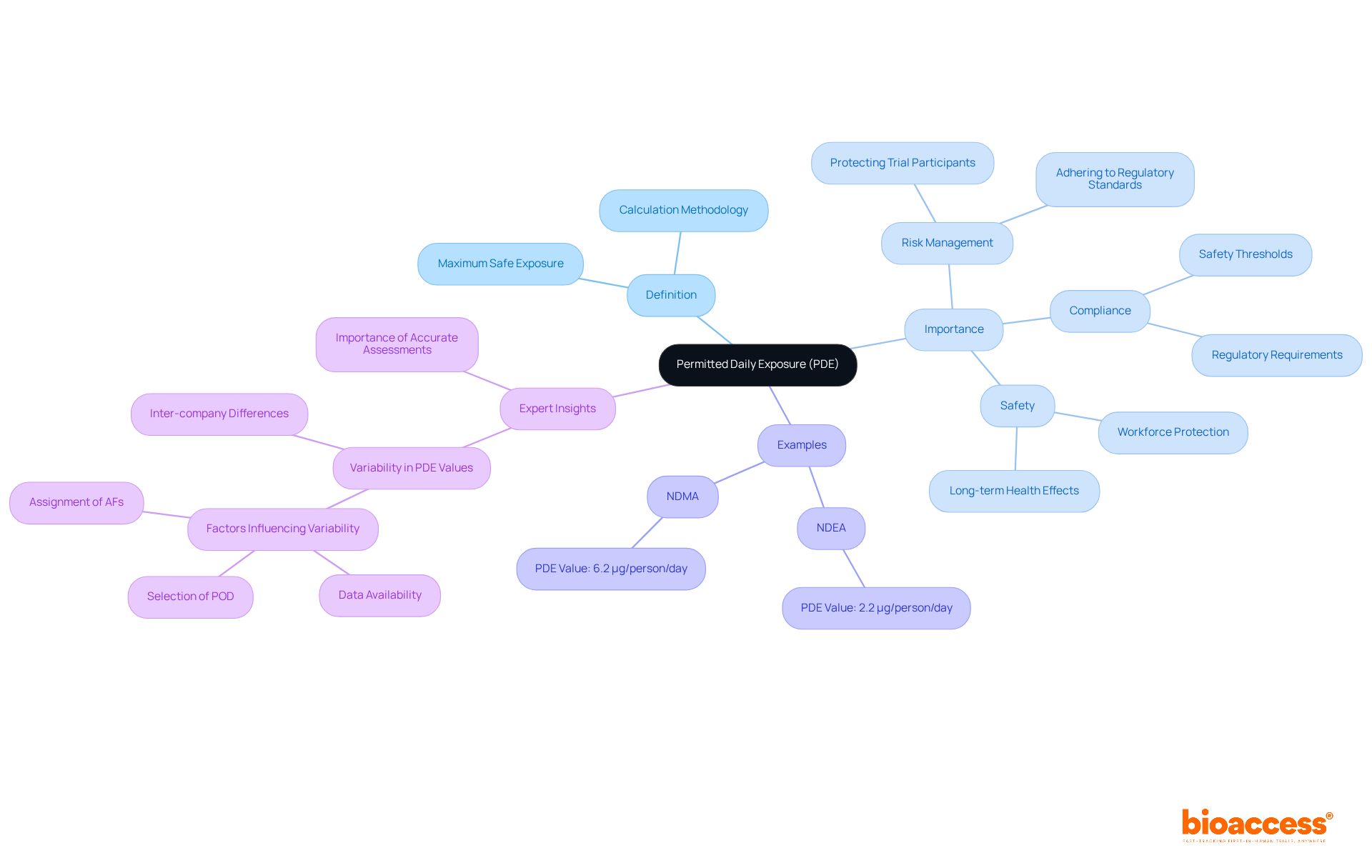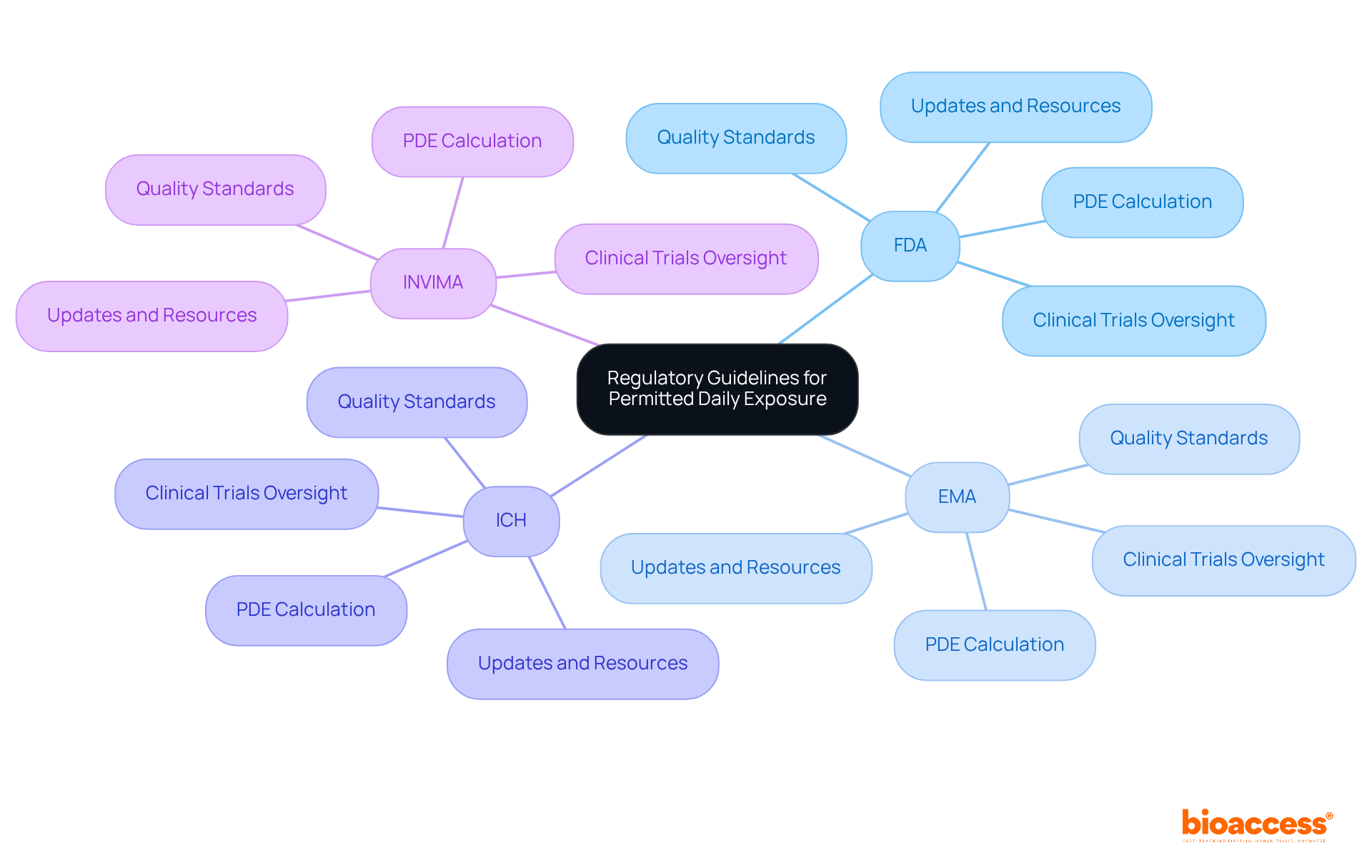


The article underscores the critical importance of Permitted Daily Exposure (PDE) calculations in clinical research, highlighting their essential role in safeguarding participant safety and ensuring compliance with regulatory standards. By detailing the methodologies for calculating PDE, it establishes a strong foundation for understanding how these calculations are integral to clinical trials.
In the ever-evolving Medtech landscape, adhering to established guidelines from regulatory bodies is paramount. These guidelines not only enhance the credibility of clinical research but also significantly reduce the risk of adverse effects during trials. The positive impact of precise PDE calculations cannot be overstated; they serve as a vital tool in minimizing potential risks, thereby fostering a safer environment for participants.
As we navigate the complexities of clinical research, collaboration becomes increasingly important. By working together and sharing insights, stakeholders can address key challenges effectively. The next steps involve a commitment to rigorous PDE calculations and a collective effort to uphold the highest standards of participant safety.
Understanding permitted daily exposure (PDE) is crucial for ensuring the safety and efficacy of clinical research, especially in pharmaceutical and medical device studies. This vital metric defines the maximum amount of a substance that can be safely encountered daily, influencing everything from trial design to regulatory compliance.
But how can researchers effectively navigate the complexities of PDE calculations while adhering to stringent safety standards and regulatory guidelines? This article explores the methodologies, regulatory frameworks, and real-world applications of PDE, equipping researchers with the knowledge needed to master this essential aspect of clinical trials.
The permitted daily exposure calculation defines the maximum amount of a substance that an individual can safely encounter daily over a lifetime without experiencing adverse health effects. This metric is crucial in medical research, especially within the pharmaceutical and medical device sectors, as it sets safety thresholds for potentially harmful substances. By accurately determining the permitted daily exposure calculation, researchers ensure that exposure levels remain within safe limits, thereby protecting trial participants and adhering to regulatory standards.
The importance of PDE extends beyond mere compliance; it plays a vital role in the risk management strategies employed in research studies. For example, the permissible daily exposure for N-Nitrosodiethylamine (NDEA) is established at 2.2 μg/person/day concerning cancer risk, while for N-Nitrosodimethylamine (NDMA), it stands at 6.2 μg/person/day. These figures illustrate how the permitted daily exposure calculation directly influences protocols in drug development.
Furthermore, expert insights highlight the necessity of thorough assessments of the permitted daily exposure calculation. Varun Ahuja emphasizes that keeping exposure within acceptable levels is essential for safeguarding the workforce from harmful effects. This viewpoint is supported by various studies, which indicate that the variability in PDE values among different pharmaceutical companies typically remains within acceptable ranges, often below a ten-fold difference. Such consistency is critical for ensuring safety across diverse medical environments.
Real-world applications of PDE calculations, such as the permitted daily exposure calculation, are evident in the evaluation of marketed active pharmaceutical ingredients (APIs) like morphine and metformin. Comprehensive data assessments have led to the establishment of reliable PDE values for these substances. These examples not only demonstrate the practical implications of PDE in ensuring medication safety but also reinforce its foundational role in trial design and implementation.

Regulatory bodies such as the FDA, EMA, and ICH have established comprehensive guidelines for the permitted daily exposure calculation and its application in research involving human subjects. In Colombia, INVIMA (Instituto Nacional de Vigilancia de Medicamentos y Alimentos) plays a crucial role in overseeing health product regulations, including medical devices. As a Level 4 health authority acknowledged by the Pan American Health Organization and World Health Organization, INVIMA guarantees that reliability, efficacy, and quality standards are met in the pharmaceutical sector. This oversight is essential for deriving accurate PDE values, particularly through toxicological data, including the permitted daily exposure calculation and the No Observed Adverse Effect Level (NOAEL).
For instance, the ICH Q3D guideline provides a framework for the permitted daily exposure calculation (PDEs) related to elemental impurities in pharmaceuticals, ensuring that exposure limits are scientifically validated. Adherence to these rules is vital for the ethical execution of medical studies, as it directly impacts participant well-being and the credibility of research results. Recent statistics indicate that compliance with PDE regulations has significantly improved rates in clinical trials, reflecting a growing commitment to maintaining high protection standards.
Researchers must remain vigilant and informed about these guidelines. Continuous updates and resources, such as the ECA's free GMP newsletters, can help ensure that studies comply with all essential standards and regulatory requirements. Additionally, experts like Ana Criado, with extensive experience in regulatory affairs and biomedical engineering, offer valuable insights into navigating these complex regulations in Colombia.

The permitted daily exposure calculation (PDE) is a critical process grounded in toxicological data, and it involves several key methodologies essential for clinical research. Understanding how to accurately determine the permitted daily exposure calculation (PDE) is essential for ensuring participant safety and compliance with regulatory standards.
Identify the NOAEL: The first step is to determine the No Observed Adverse Effect Level (NOAEL) from relevant toxicological studies. This level represents the highest dose at which no adverse effects are observed, serving as a foundation for further calculations.
Apply Protection Factors: Next, the NOAEL is modified using protection factors to account for interspecies and intraspecies variability. A common approach is to apply a factor of 10 for each type of variability, ensuring a cautious estimate that enhances protection. Specific factors include F1 for inter-species variability and F4 for modifying severe toxicity.
The permitted daily exposure calculation is essential for ensuring safety in various environments. Calculate PDE: The formula for calculating PDE is:
PDE = NOAEL / Safety Factor
This calculation yields a substance-specific daily dose that is unlikely to cause adverse effects, providing a crucial benchmark for safety in clinical settings. For instance, a default PDE of 100 μg/day may be chosen for substances presumed to have low activity, while highly hazardous materials correspond to a PDE value equal to or below 10 μg/day.
By following these steps, researchers can obtain a scientifically sound permitted daily exposure calculation (PDE) that prioritizes participant welfare in research studies. Understanding the NOAEL determination process is essential, as it often involves comprehensive analyses of toxicological studies, where the absence of adverse effects is meticulously documented. This nuanced understanding of NOAEL statistics is vital for accurate permitted daily exposure calculation, ensuring that all potential risks are adequately assessed and managed. The calculation process is guided by the European Medicine Agency's guidelines (EMA/CHMP/CVMP/SWP/1694/2012), which provide a framework for establishing safe exposure limits.

The impact of the permitted daily exposure calculation on clinical studies is significant and multifaceted. PDE directly shapes study design, compelling researchers to ensure that dosing regimens align with the permitted daily exposure calculation. This adherence is vital for minimizing the risk of adverse effects among participants; exceeding these limits can pose serious health risks. In fact, an analysis of 475 trials involving over 27,000 participants revealed a median rate of serious adverse events of zero per 1,000 participants daily, underscoring the effectiveness of following PDE guidelines in enhancing participant safety.
Furthermore, evaluating PDE is essential for identifying potential issues related to drug impurities, which can substantially affect the overall risk profile of a study. Deriving accurate PDE values is crucial for assessing the risks associated with impurities in pharmaceuticals, ensuring that drug formulations comply with exposure limits and safeguard public health.
Understanding PDE also fosters improved communication with regulatory agencies, reflecting a commitment to participant safety and adherence to established guidelines. This proactive approach can significantly enhance the likelihood of regulatory approval, as compliance with PDE regulations demonstrates the industry's dedication to maintaining high standards. Additionally, bioaccess's comprehensive management services for research studies—including feasibility assessments, compliance evaluations, and study setup—facilitate the effective implementation of these protective measures, ultimately bolstering the reliability and success of research.
In conclusion, evaluating the permitted daily exposure calculation (PDE) is fundamental to the successful execution of research studies, ensuring that they are both ethical and scientifically sound. By adhering to PDE limits, researchers can mitigate risks associated with impurities and enhance the overall safety of clinical trials.

Understanding the permitted daily exposure (PDE) calculation is crucial for ensuring safety and compliance in clinical research. This metric acts as a vital benchmark, safeguarding participants from potential harm while adhering to regulatory standards. By accurately calculating PDE, researchers can effectively manage risks associated with drug exposure, thereby reinforcing the integrity and ethical foundation of clinical trials.
The significance of PDE spans various aspects of clinical research, including its pivotal role in:
Thorough assessments and adherence to regulatory guidelines are essential, as is the methodology involved in calculating PDE. Real-world applications illustrate how established PDE values influence the safety of marketed pharmaceuticals and shape the overall framework for research studies.
Ultimately, the emphasis on permitted daily exposure highlights a commitment to participant safety and the ethical execution of clinical trials. Researchers must prioritize PDE calculations, stay informed about evolving guidelines, and engage with regulatory bodies. This proactive approach ensures that their studies not only meet safety standards but also contribute to the advancement of medical science. By doing so, they enhance the reliability and success of their research initiatives, ultimately benefiting public health and safety.
What is Permitted Daily Exposure (PDE)?
Permitted Daily Exposure (PDE) defines the maximum amount of a substance that an individual can safely encounter daily over a lifetime without experiencing adverse health effects.
Why is PDE important in clinical research?
PDE is crucial in clinical research as it sets safety thresholds for potentially harmful substances, ensuring that exposure levels remain within safe limits to protect trial participants and adhere to regulatory standards.
How does PDE relate to risk management in research studies?
PDE plays a vital role in risk management strategies employed in research studies by determining safe exposure levels, which influences protocols in drug development.
Can you provide examples of PDE values for specific substances?
Yes, the permissible daily exposure for N-Nitrosodiethylamine (NDEA) is established at 2.2 μg/person/day concerning cancer risk, while for N-Nitrosodimethylamine (NDMA), it is set at 6.2 μg/person/day.
What do experts say about the assessment of PDE?
Experts emphasize that thorough assessments of the permitted daily exposure calculation are essential for safeguarding the workforce from harmful effects, with studies showing that variability in PDE values among different pharmaceutical companies typically remains within acceptable ranges.
How are PDE calculations applied to marketed active pharmaceutical ingredients (APIs)?
Real-world applications of PDE calculations are evident in the evaluation of marketed APIs like morphine and metformin, where comprehensive data assessments have led to the establishment of reliable PDE values for these substances.
What is the significance of consistent PDE values across medical environments?
Consistency in PDE values, often below a ten-fold difference among pharmaceutical companies, is critical for ensuring safety across diverse medical environments and reinforces the foundational role of PDE in trial design and implementation.